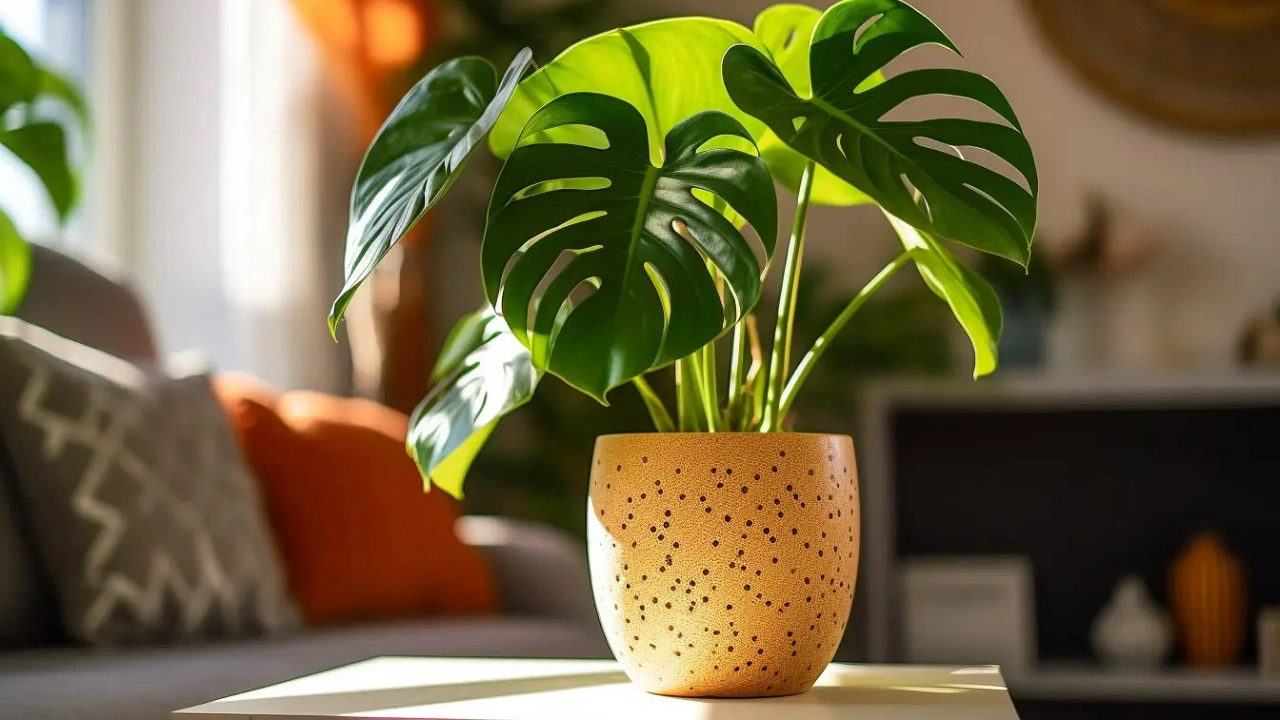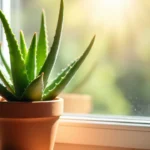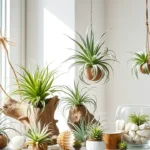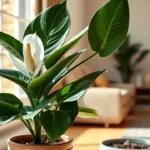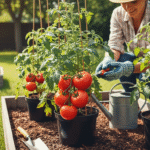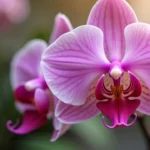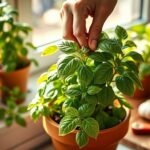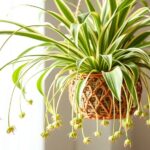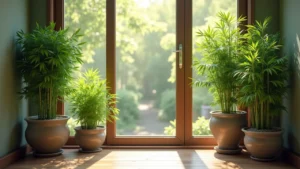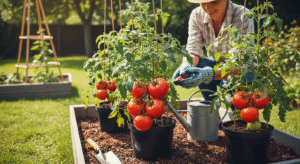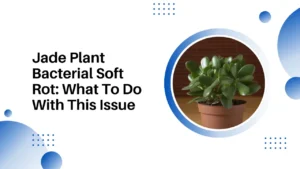In this article, we are going to discuss a very recognizable plant with big and beautiful leaves. Monstera plant, this tropical plant can be tough to take care of if you live in colder climates, however, you can still be successful with this plant. Curious to know how?
Here, I am going to share the easiest way to grow and care for Monstera so that even beginning plant parents will be able to care for this plant. As they are low-maintenance plants, they are a great beginner choice.
In this guide, we will go over a few different topics and how you can help your Monstera thrive at your place. These topics include propagation, care tips, and additional care. Plus, its benefits.
After finishing reading this guide, you will have all the information you need to take care of these beautiful tropical plants.
Table of Contents
About Monstera Plant
| Characteristic | Details |
|---|---|
| Common Name | Monstera, Swiss Cheese Plant |
| Scientific Name | Monstera deliciosa (most common species) |
| Plant Type | Tropical evergreen, climbing vine |
| Native Region | Tropical rainforests of Central and South America |
| Light Requirements | Bright, indirect sunlight; tolerates low light but grows slower |
| Soil Type | Well-draining, rich soil; prefers a mix of peat moss and perlite |
| Watering Needs | Water when the top 2 inches of soil are dry; avoid overwatering |
| Temperature Range | 65–85°F (18–29°C); not frost-tolerant |
| Humidity | Prefers high humidity; benefits from misting in dry environments |
| Fertilizer | Feed monthly during spring and summer with a balanced liquid fertilizer |
| Mature Size | 6–8 feet indoors; up to 20 feet outdoors in optimal conditions |
| Growth Rate | Moderate to fast; rapid growth in the right conditions |
| Toxicity | Toxic to pets and humans if ingested due to calcium oxalate crystals |
| Common Pests | Spider mites, mealybugs, scale insects, and aphids |
| Propagation | Easily propagated via stem cuttings in water or soil |
| Special Features | Iconic split leaves, air-purifying qualities, and trendy indoor appeal |
Types of Monstera plants
1. Monstera Deliciosa
This is the most common type of Monstera we all know and love, you will easily find this one when you go plant shopping. This plant will attract you with its big and gorgeous holey leaves that are widely famous in nurseries and home decor right now. You will never go wrong with this Monstera plant.
Fun Fact: It has got its name “delociosa” because this plant produces Mexican breadfruit.
2. Monstera Borsigniana
This plant is actually a variation of a previous plant and might sell under the same name (deliciosa) as it is hard to distinguish between the two when they are young.
However, there is one way to tell the difference between the two, look at their stem. Deliciosa have a ruffle, pucker, or form cute little bumps where the leaf is attached to the stem, but Monstera Borsigniana doesn’t have such a type of stem.
Borsigniana is also smaller but grows faster than deliciosas. Mature Borsigniana forms 2 neat rows of holes or slits instead of growing holes in a willy-nilly style like deliciosa.
If you end up growing Borsigniana instead of a deliciosa, fear not! With proper care, you might grow bigger and faster Borsigniana, which will surely add beauty to your home.
3. Monstera Variegata
Do not misunderstand this plant as a separate Monstera Variety, this plant only varies in color. But this Variegated monstera plant is so interesting, it looks like the plant is painted with white color. You are surely going to love them!
Variegated means plants that are having a pattern of white or cream as well as green color. Also, they are pretty hard to find, and hence, they are expensive.
4. Monstera adansonii
This variety is smaller than the deliciosa, but they are having large holes. The holes take up about 50% of the leaf.
Moreover, this plant is fairly easy to find, sometimes they are mislabelled as Monstera obliqua (true Monstera obliqua are extremely rare, so you can be assured that whenever you see this label in the nursery, that’s Monstera adansonii. Also, Adansonii has thicker and rougher leaves than obliqua.
5. Monstera Pinnatipartita
These plants have very large, glossy leaves, but they grow slits, rather than holes, that go to the edge of the leaf. The leaf stems are stiff and sturdy and they have a stunning emerald green color. Also, these are a little harder to find, but you can source one or two online.
6. Monstera Dubia
These are mostly loved ones! This type is characterized by very small, heart-shaped leaves with both dark and light green coloration. The plant grows like a vine with shorter leaves and stems that grow closer to whatever it is climbing.
These are tricky to find, so, if you do see one, snatch it up!
7. Monstera Siltepecana
This lovely plant has large, teardrop-shaped leaves with smaller holes concentrated around the central vein. Often, they are lighter in color than other Monsteras and contain both dark and light green hues. They are also hard to find, but beautiful if you can get your hands on one.
8. Monstera Obliqua
It’s sad to tell you that this one you won’t find at Home Depot or anywhere else, really. However, it’s so cool that I couldn’t resist including it.
These amazing plants still have the characteristic holes, but the leaves tend to be more holes than leaves! The holes can take up to 90% of the paper-thin leaves, hence these plants are extremely delicate and you won’t find them in nurseries.
However, if you are lucky, you can catch them in some botanical gardens.
Fun fact: This Monstera variety has only been spotted 17 times in the wild and is often studied for cross-breeding with other varieties.
9. Rhaphidophora tetrasperma or “Mini Monstera”
Although this plant isn’t technically a monstera (you’ve probably noticed “monstera” isn’t in its scientific name), it looks wonderful when displayed with one!
Mini Monstera is like a smaller version of monstera with the same characteristic holes in the leaves, though the large holes tend to reach all the way to the edge of the leaf and appear more notched. The deep green color of this plant is stunning, and these are more common than some of the rarer monstera varieties and can be easily maintained.
How to Propagate Monstera plants
After learning this propagation method, your friends will beg you to share your Swiss Cheese Plant (Monstera Plant) with them, and the good news is it is too easy to propagate.
Here the best advice is to just accept that it might not work at first, anyways try!
Monsteras are easier to propagate than most plants, and there are multiple ways to do so. Firstly, you can prune your Monstera by cutting off a large part of the stem. By doing this, you can ensure your Monstera has enough water and nutrients to grow roots independently.
The other option is to wait until the Monstera starts to grow air roots. Once the air roots get developed, your Monstera is telling you that it is ready to propagate. By putting this cutting in water, the Monstera stem will grow new roots and become an independent plant. As the roots develop, it is ready for planting in soil. There you have it, your own plant, for free!
Monstera Plant Care
Once you follow these care instructions, you will be able to grow a stunning Monstera plant. In this guide, I will tell you how to water a Monstera, its light, humidity, temperature, and additional care tip.
Light Requirements for Monstera Growth
Do you know that you can grow this plant anywhere in your home?
Monstera tolerates low light but it grows fast and becomes more dramatic in a spot with bright light. However, avoid strong and direct sunlight as it may burn the leaves.
If you are not having an ideal lighting location, consider using grow light.
As a tropical plant, it is no surprise that your Monstera enjoys warm temperatures between 20°C-30°C. A little humidity is enough for Monstera. So, you can consider growing them in bathrooms and kitchens where they can get a touch of humidity or you can do misting now and then.
Also, Monstera grows naturally in the dappled light of the forest. In order to mimic that, place your plant in bright or filtered, indirect light. However, they can grow in deep shade, but may not exhibit much leaf foliage.
If you are living in Zones 10 or 11, you can grow Monstera outdoors in a shady spot.
How to Water Your Monstera Properly
Water your Monstera when the topsoil is 50%-75% dry. Also, water until liquid flows through the drainage hole and discard any excess water.
Humidity for Healthy Monstera Plant
Although Monstera plants can thrive in almost any environment, you can give them a special treat by gently misting them once a week using a mister. It is best to mist your Monstera early in the morning so the water will have plenty of time to evaporate before evening.
When grown indoors, Monstera plants like temperatures from 15°C-23°C. Humidity levels from 50% to 75% are ideal for most indoor plants, and Monstera enjoys its humidity on the high side.
If you are having dry air inside your home, Monstera will develop brown spots on the tips or sides of their leaves. To promote the humidity, lightly mist the plants several times a week with a spray bottle filled with water.
Remember to keep your Monsteras away from heating and air conditioning vents. Also, keep them out of drafts, too, which may be too cool for the Monstera to tolerate.
Monstera Plant Temperature Needs
Normal room temperatures between15°C-26°C are highly suitable for your Monstera. Your Monstera will not tolerate temperatures under 12°C or sudden falls in the temperature. Hence, avoid cold drafts and direct airflow from heaters in the winter.
Fertilizer Tips for a Healthy Monstera Plant
For best results, fertilize your Monstera plant once a month throughout the spring and summer, with an All-Purpose Fertilizer (20-20-20). A little bit of feeding will go a long way to promote growth and root health.
Avoid fertilizing your plant during winter, it is important to give them a chance to rest during the winter.
Repotting Monstera Plant
Your young Monstera will need repotting every year to encourage its growth. While repotting your young plant, make sure to add soil nutrients. Gradually, increase your pot size by 2 inches per year. Once your Monstera has reached its optimal height for your space, give it a top dressing of new soil once a year and re-pot it every 3 years.
While repotting always use quality potting soil to keep the soil moist but free-draining. Monstera is a natural climber that uses its roots to hold on to trees. So, when you re-pot make sure to add a trellis or moss to your plant.
Also, replant your plant annually to replenish its nutrients and give its roots more space to grow. The best time to do repotting is in the spring, just before new leaves emerge. At that time, use a pot that is 2 inches bigger than the current one each time you replant your Monstera plant. When your plant becomes as big as you want, stop repotting it.
Remove your plant from its old pot by holding the base and wiggling it slightly to free the roots. While handling your plant with large leaves, wrap them loosely in a soft towel to prevent damage. To loosen roots in a small pot, hold the base of the plant so it won’t fall out. Next, flip the pot upside down and tap the bottom.
Upon removing the plant, gently shake its roots to remove any old potting soil clinging to them. If any parts of the plant appear dead or unhealthy, trim them off. Repot the plant in a new, larger container. Make sure the pot is deep enough to hold the stake and plant without tipping over. If needed, add a new stake that is taller than the plant and use plant ties to hold the stems to the stake. Now, fill the pot with fresh potting soil, covering the base roots and any aerial roots that go into the soil.
After potting or repotting, water your plant deeply and let it drain. If excess water collects in the saucer underneath your plant, dump it out.
When the Monstera is as big as you want, refresh the top couple of inches in the pot with a new potting mix. Remove some of the old mixes first, to make room for the new, Also, be careful not to damage any roots when you do so.
The next step is pruning, so, let us prune the Monstera as needed to maintain its size
Monstera Plant Pruning Tips
Young Monstera plants have compact and bushy habits. As young Monstera grows, it begins to show its vining nature. At that time, you can either give them support to climb and allow them to grow tall and dramatic or you can pinch them off.
Pinch the new growth tip with your finger at the height you want it to stay. Also, feel free to prune out the stems that are developing a few new leaves. If you are unable to tuck the aerial roots back in the container, remove them as well.
Common Pests That Affect Monstera Plants
Monstera is rarely attacked by pests or diseases. You can wipe off the leaves with a damp cloth from time to time or give them a shower to remove dust. However, just check for spider mites when you do. Monstera is a long-lived house plant that will give you years of pleasure with little care.
Toxicity
The leaves of Monstera are mildly toxic to pets and humans. Typically, when ingested it causes mouth and stomach irritation and possible vomiting.
Care for Shiny Leaves
Wipe the leaves occasionally with a soft and damp cloth. This will remove dust and dirt so that the leaves can stay glossy-looking and get sufficient light.
While cleaning the leaves or simply watering your plant, look for spider mites, scale, mealybugs, or other plant pests. If they show up, treat them as soon as possible with a pest control product, also follow the instructions on the label.
Additional Care
Monstera’s large leaves collect dust. If you notice the leaves are dirty or dusty, wipe the leaves with the help of Microfiber Dusting Gloves to keep them clean and healthy. In the wild, Monstera plants like to climb. To encourage your Monstera to climb upwards, you can stake wild offshoots with a dowel or use a moss pole. To prune your Monstera, be sure to use clean, sharp plant snips.
Benefits of Monstera Plant
There are a lot of advantages to growing Monstera Plant:
- The most important benefit is that the Monstera plant makes your home or office more attractive with its beautiful unique leaf patterns.
- Also, it purifies the air and is useful in humidifying air conditions.
- It produces fruits that are full of vitamin C, proteins, some vitamin B, calcium, and phosphorous, (it is poisonous if it does not fully ripen).
- Additionally, it can cure different diseases and health problems such as arthritis and insect or snake bites.
Though it certainly is beneficial for the points mentioned, it should be noted that its high doses can cause diarrhea and stomach cramps. Furthermore, its roots and leaves are toxic to humans and animals.
Conclusion
As you can see, this Monstera plant is a beginner-friendly plant. It does take some time to get used to it if you’re coming from succulents or cacti.
However, by following the tips in this guide, you will be able to help this plant grow well. Also, by taking care of Monsteras properly, you will be able to enjoy this plant for many years and grow it as large as you want to.
Also, it comes with beautiful varieties, after learning all these, try one of these large beautiful Monstera plants to bring life and a big personality to your room.
Grow one and you will find them pleasantly easy to care for and a lot of fun to raise!
If you have any queries, feel free to ask us in the below comment section!
FAQs
Q1. How often should I water Monstera plants?
For watering Monstera, there is no set rule, however, you should let your plant dry out between watering. Remember, to water only when the top half of the soil is completely dry. Also, keep your Monstera plant in a porous pot, this will allow extra moisture to evaporate and avoid root rot.
If you are noticing leaves turning yellow or the stems turning black, chances are your Monstera is getting too much water. On the other hand, if leaves are getting curled or wilted, then your plant is not getting enough water.
Most Monstera plants need more water in the summer. In addition, fertilize your plant during summer, this will encourage its growth.
Q2. Are Monstera plants toxic to cats?
Usually, tropical plants are toxic and the Monstera plant is no exception. The sap of the stem and leaves causes indigestion and vomiting in both humans and pets. Hence. Try to keep your monstera plant away from the children and pets if you know they will try to nibble the stems and leaves of the plant.
Q3. How to fix yellow leaves on the Monstera plant?
When you notice yellow, brown, or black tips on your Monstera leaves, it’s a clear sign of overwatering.
So, the best thing to do right now is to stop any watering, drain the excess water from the soil and then let the soil dry out before watering again. If you see your plant has developed root rot, it’s best to re-pot the Monstera plant and add some fresh (dry) soil.
A rule of thumb to use when watering is this; only water your Monstera plant when the topsoil (2-3 inches) is dry. By not checking this, you are putting your Monstera at risk of overwatering.
Q4. Which soil is best for the Monstera plant?
Monsteras prefer moist soil, but don’t deal with wet soil very well. To give the Monstera the right amount of moisture to thrive in, use well-draining soil. You can avoid letting water sit at the bottom of the pot by choosing a pot with a good drainage system.
Your Monstera will retain all the water it needs to thrive, but any excess will drain away from the bottom. This way, you won’t have to worry about an overwatered plant and root rot.

